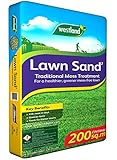Theperfectgarden.co.uk may earn a small commission (at no extra cost to the user) from Amazon and other online retailers if a purchase is made after clicking a link. I appreciate your continuing support.
Moss is a major headache for lawn lovers. Unfortunately, in reality, most lawns will be rarely free of moss, this is due to our ever-changing climate and the conditions our lawns grow in.
Take each season as it comes. Large amounts of moss can easily be treated with fertilizers containing iron (ferrous sulphate). Some examples are Lawn Sand and Evergreen Moss Kill. Repeated practice of using fertilisers containing iron coupled with moss removal and aeration will help keep moss from getting a hold on your lawn.
It is always best to treat moss early in the spring, which is why we prefer to use lawn sand, this has a small nitrogen content but a very high iron content. The iron will hammer the moss and the nitrogen will give the grass a “pick me up” tonic.
Apply the fertiliser when the lawn is damp and rain is NOT imminent the iron needs to sit on the moss for at least 24 hours (36 hours is best) to work its magic. After this period, rain or a watering would be perfect to wash the nitrogen into the soil. After 3-5 days the moss will start to turn black. Leave for a week or two and then remove with a plastic rake. We prefer these PLASTIC RAKES as they are lighter to use. The plastic tines don’t dig into the turf like a metal rake would, making the job a lot less hard work.
If the moss is very thick it may be worth hiring a scarifying machine from your local hire shop for around £40 for half a day or even investing in your own. There are plenty to suit your budget from electric to petrol machines.
Read Our Post On How to Choose a Lawn Scarifier/ Lawn Rake
Can I use an All-in-One Weed, Feed and Moss Killer?
Yes, you can. These all-in-one lawn products are very effective and can be used from March through to September. The trick to getting the most out of these lawn fertilisers is getting the timing right. You want the granules of the all-in-one to sit on the moss and the weeds for about 24 – 36 hours before rainfall.
Don’t worry if forecast rain doesn’t arrive, you can always use a sprinkler to wash the granules into the soil. The lawn will often go dark and sometimes even black, this is normal as the iron and lawn weed killer does its thing.
Tips
- Moss loves damp compacted areas of soil (You will notice moss growing on porous roof tiles and brick wall tops). The more you can keep the surface of your lawn open by raking or aeration the less chance moss will have to grow.
- Creating good drainage. Hollow tining or spiking your lawn will allow the surface water to drain away. AERATION SHOES may look ridiculous but they are brilliant and really do help to break up the surface allowing gases to escape and get fresh air into your lawn.
An Alternative to Killing and Removing Moss
No Rake Moss Removers are becoming the moss killer and fertiliser of choice. Ideal for gardeners who struggle to remove the dead moss by means of raking or scarifying.
These fertilisers use large doses of Potassium to kill the moss, the moss then breaks down and is consumed by an already present bacteria, Bacillus.
Although this can be a slower process of removing the moss and fertilising the lawn, usually around 3-4 weeks, the potassium element builds strong disease-resistant grass compared to the fast, grass growing nitrogen-based fertilisers we have been used to in the past.
Mo Bacter
We have been using Mo Bacter in areas of the garden. Another no rake moss remover that breaks moss down naturally. On purchase we were quite sceptical however, we have experienced some very good results.
This fertiliser/moss killer really does eat the moss, breaking it down to produce an organic fertiliser directly to your lawn.
In fact, it does such a good job you don’t need to rake the moss out at all.
It’s now May and the areas of grass that we treated with Mo Bacter are considerably greener with more prolific growth than surrounding areas and no moss. I would call that a successful product.
Mo Bacter is quite expensive compared to other moss killers but if you are not a fan of raking the moss out, then this could be for you.












